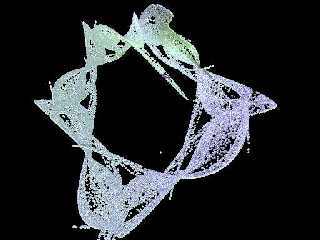|
 |
>>Do I understand it correctly that the attractor is a surface (or could
>>be represented as one)? It looks like it, so you could try to build a
>>(smooth) mesh from it. Then you could also do fancy stuff like nice
>>finishes etc. Of course you'd need POV again to do so.
>
>
> No, it's not a surface. It's a bunch of points on a 2D-coordinate system.
> They look 3D, but they aren't.
Which is not to say that you can't have 3D attractors. I wrote a quick
and dirty hack to search for sets of coefficients for a 3D quadratic
that produce nice attractors a while ago, I've been meaning to work on
it, perhaps I'll clean it up and post it here if anyone's interested.
The trouble with rendering it as a solid object is that you have no more
information than the location of each point - other than simple
proximity there is no way of knowing whether two points should be
connected forming part of a surface, or whether there is a gap between
them that should not be filled. In the end you either just plot so many
points that it looks like a single surface, or use a guessing algorithm
designed to form a surface from a collection of points.
The sample attaced is rendered by plotting each of the 65536 points as a
sphere. It looks a little flat, but you can see where a bit of it sticks
in front of the rest at around 8 o'clock, and a bit of twisting from
around 11 o'clock to 2 o'clock.
Post a reply to this message
Attachments:
Download 'attractor3d.jpg' (25 KB)
Preview of image 'attractor3d.jpg'

|
 |




![]()